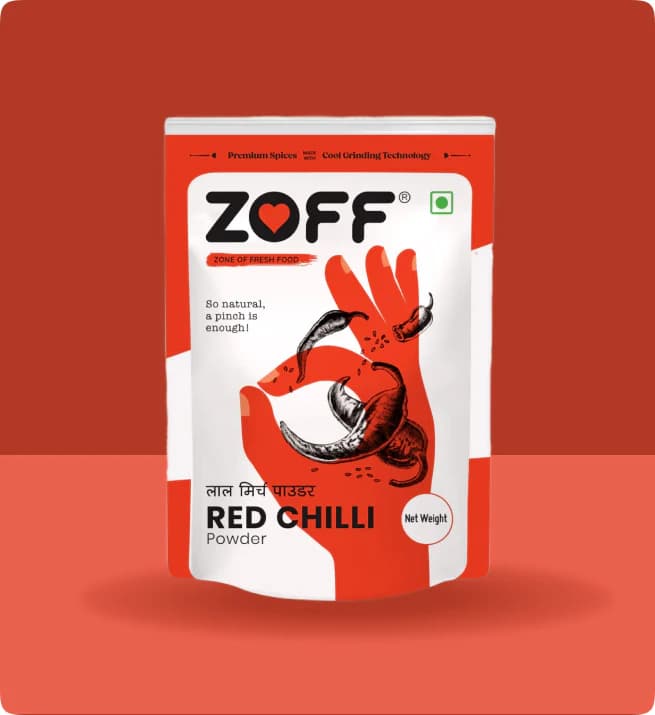In today’s fragmented commerce landscape, one-size-fits-all packaging no longer works. The rise of multiple sales channels, quick commerce , direct-to-consumer (D2C), and traditional retail demands differentiated strategies tailored to each touchpoint.
Product packaging is no longer just about protection; it’s about delivering convenience, experience, sustainability, and storytelling, depending on where the product is sold and consumed. At ZOFF Foods, we are committed to making everyday spices fresher, safer, and more appealing. This shift has been a game-changer.

In the retail industry, a product’s packaging has a mere two to three seconds to capture a shopper’s attention. It’s a crowded, competitive landscape where brands fight for visibility on a physical shelf. Here, packaging is the primary marketing vehicle.
Lets look at some of the key design principles for retail.
Visibility And Standout PowerThe packaging must be visually striking and instantly recognisable. Bold colors, unique shapes, and clear typography are essential to cut through the noise. Think of the iconic Coca-Cola bottle or the vibrant packaging of a Kellogg’s cereal box.
A study by the Paper and Packaging Board found that 72% of consumers say that a product’s packaging can influence their purchasing decision. ZOFF Foods’ spice packs use bold colour coding: deep reds for chilli, rich yellows for turmeric, paired with clean, contemporary typography.
Clarity And Information HierarchyThese not only pop against a sea of traditional spice packets but also help shoppers quickly identify their choice.
With limited time, the packaging needs to communicate essential information quickly. The product name, brand logo, and key benefits must be prominently displayed. Consumers should be able to understand what the product is and why they need it without having to pick it up and scrutinse it
Durability And Shelf PresenceThe packaging must be robust enough to withstand handling by staff and customers, as well as the rigors of transportation and stacking. A flimsy or easily damaged box sends a message of poor quality. The package must also sit well on the shelf, presenting a clean, consistent face to the shopper.
Honesty In PackagingFor example, ZOFF Foods uses multi-layer laminated pouches that stand upright and resist tearing; a key advantage when packets are handled repeatedly
The visible spice window is ZOFF’s way of saying, “What you see is what you get,” avoiding the disappointment of oversized, under-filled packs
The D2C Experience: The Unboxing RitualD2C brands bypass traditional retail and sell directly to the customer, often through their websites. This model shifts the focus from winning on a shelf to creating a memorable and shareable unboxing experience.
Here, packaging is not just a container; it’s a physical extension of the brand’s digital identity and the final, tangible touchpoint.
Here are some of the key design principles for D2C.
The Unboxing JourneyThe D2C package is an opportunity for storytelling. It begins with the outer shipper box and continues with inner tissue paper, branded tape, and custom inserts. The experience should be a carefully choreographed reveal.
Premium And Personalised TouchesD2C packaging often uses higher-quality materials and finishes to convey a sense of luxury or exclusivity. This is where personalised elements like a handwritten thank you note, a custom sticker, or a small free sample can make a huge impact.
According to a Dotcom Distribution study, 55% of consumers who watch unboxing videos say the video convinced them to purchase the product. For example, we have ziplock packaging for easy storage.
Sustainability And Brand ValuesMany D2C customers are younger and more environmentally conscious. Sustainable, recyclable, or reusable packaging is a major differentiator. Brands like Allbirds or Glossier have built a reputation for their minimalist and eco-friendly packaging, which reinforces their brand values.
Protecting The Product, But SmarterWhile protection is still paramount, D2C packaging can be more creative and less about withstanding the retail environment. It’s about ensuring the product arrives in pristine condition while also delighting the customer. This can mean using custom inserts that hold the product securely or void fills that are part of the brand’s aesthetic, like branded paper shreds instead of traditional plastic peanuts.
Quick Commerce: The Need For Speed And EfficiencyQuick commerce promises delivery in minutes, not days. This channel, dominated by platforms like Instacart, Gorillas, or Gopuff, introduces a new set of challenges and priorities for packaging. The primary objective is to get the product to the customer safely and efficiently, with minimal fuss.
Here are some of the key design principles for quick commerce
Absolute Efficiency And DurabilityThe packaging must be easy to pick, pack, and transport. It needs to be lightweight and compact to fit in delivery bags and on bike racks. The focus is on functionality over frills. The outer packaging may be a generic, unbranded bag from the delivery service, so the product’s primary packaging must be a silent, yet robust, protector
Clear, Bold IdentificationIn a warehouse or micro-fulfillment center, speed is everything. The product must be easy to identify at a glance. Large, clear labels, a distinct product name, and a visual that immediately tells the fulfillment worker what it is are critical. Think of a brightly colored energy drink can or a snack bag with a clear window
Safety And Tamper-EvidenceIn a rapid delivery model, the risk of tampering or damage is a concern. The packaging must be secure and tamper-evident, giving the customer confidence that the product is untouched. This could be a sealed lid, a security seal, or a robust closure
Minimalism And Environmental ResponsibilityGiven the sheer volume of quick commerce orders, excessive or bulky packaging is a liability. Brands should prioritise minimal, functional, and ideally, recyclable materials. Quick commerce is about a transaction, not an unboxing ritual, so the packaging should reflect that; it’s there to protect, not to perform.
The Future Of Packaging: A Three-Pronged StrategyThe evolution of ecommerce has fractured the traditional approach to product packaging. There is no longer a one-size-fits-all solution. Retail packaging is a billboard, D2C is a storyteller, and quick commerce is a logistical safeguard. The most successful brands understand these distinctions and design their product packs accordingly, creating a seamless and appropriate experience for each channel.
Ultimately, packaging design is a strategic decision that goes far beyond aesthetics. It’s about aligning a brand’s visual identity with the practical realities of its sales channel.
As renowned designer Paul Rand stated, “Design is so simple, that’s why it is so complicated.”
The art of packaging design lies in its ability to simplify this complexity, delivering a perfect solution that works, delights, and sells; no matter where the customer finds it.
The post The New Packaging Playbook: Visibility, Storytelling, and Speed appeared first on Inc42 Media.
You may also like

'If it means going to jail, so be it': Air Canada union chief vows to fight; strike enters third day despite back-to-work order

Strictly celebrity pairings 'revealed' and one star who could be 'benched'

Video: Rajasthan medical intern asked to remove veil for patient safety; triggers row

Arunachal Assembly upholds spirit of democracy by promoting participatory governance: Guv Parnaik

Mild Earthquake Hits Dharamshala, Heightening Seismic Concerns






